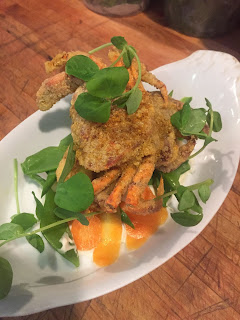As we approach July, the green crabs are still going strong (well, most of them), and so are we! This past weekend, a mysterious thing happened...many of our crabs in the two tanks we had died--for no apparent reason. We are on the case though, working through all the possible options of why this could be. Usually there are a few that die or get eaten every weekend, but this was more than usual. We checked the other tanks in the room (being used for other research projects, and they did not seem to have a problem though). We thought maybe, due to the great amounts of rain we have been getting over the past week, the pH, salinity, or temperature could have changed caused it. But the water is from the estuary right next to the lab, and there were still many alive green crabs there, plus green crabs are supposed to be very resilient, which is one of the reasons they are so good at being invasive. The water to the tanks was still running and there was not a drastic change in temperature. So, we kept thinking; what else could've caused this massive die out? Our conclusion came the next day, when we were monitoring the tanks. All of the sudden, the water going into only our two tanks just turned off. All of the other tanks still had water flow. It eventually turned back on but before it came back to full force, for a while was barely spurting little bits of water. So, we came to the conclusion that this happened without anyone's knowledge over the weekend, the water became anoxic and many of the crabs suffocated. We are still investigating the reason for this water shortage to our tanks.
So, because of this, we need more crabs! We set out traps at different places such as Seabrook and a place off of Route 4, then moved them farther off the coast. All of these sites have proven good places to catch green crabs, and have turned up with a good number of crabs. I got over 200 crabs in one night off just the first two places! So we have managed to get more crabs and are now monitoring them as well, and making sure that the water stays flowing to their tanks. Additionally, we are always looking for people to help us with citizen science to get data that way, so if you are interested in helping with the project in any way or find a green crab and feel so inspired to record a few things about it, follow the directions on this link:
https://survey123.arcgis.com/share/cf8e11f159ec4ee08e2270f5920c3290
Thank you and until next time!
Nicole













